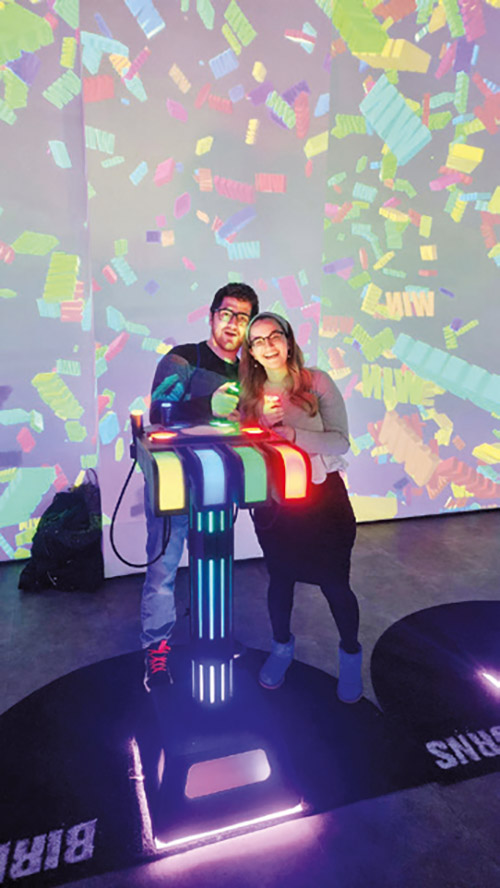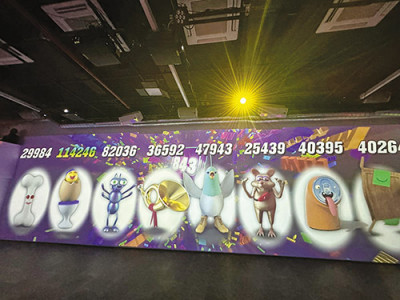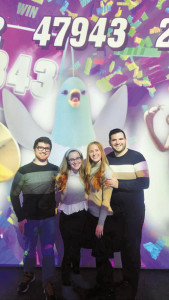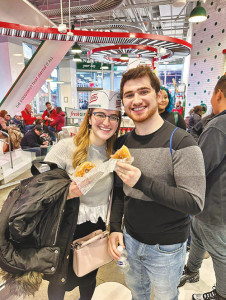
Game shows have always been a thrilling way for participants to showcase their knowledge and quick reflexes in exchange for being awarded exciting prizes. But why settle for watching others play when you can be the one experiencing the excitement firsthand? All that is required of you is to enter New York City’s Game of 1000 Boxes, an immersive and innovative game show, and you and your family will have the opportunity to compete in a live game show to win a mystery box prize. My wife Ahuva, along with our friends Zehava and Avi, joined forces to take on this thrilling challenge.
To travel to the Game of 1000 Boxes, Ahuva and I took a bus to Port Authority in New York. From there, it was just a quick walk of a few blocks to the venue. We followed a sign with the game show’s logo on an arrow, which directed us to the correct building. Inside, Avi and Zehava were already waiting for us. The friendly hostess checked us in and assigned the four of us to our own team called the Birds. Our team’s logo, a white pigeon with a mint-colored head and brown boots jumping with joy, appeared on the screen by the register.
After we registered, the hostess led us into the main game room. The room was visually impressive, with projected lights illuminating the floors and walls. Most of the lights were green and blue, spinning around like a kaleidoscope. On the main wall, the title Game of 1000 Boxes was displayed in big 3D letters. The room itself was cube-shaped, which helped us understand the game’s namesake (boxes). In front of the back wall of the room, we saw eight different podiums with four buzzers each. The podiums were lit up in different colors — red, green, blue or yellow — corresponding to the different colored buzzers. Each podium had four circles on top, and there were eight podiums in total, one for each team. In front of each podium was a mat with that team’s name; the hostess showed us our podium, which was adorned with a bird. She then briefly explained the rules: whoever pressed the buzzer would have his/her color circle light up. When a buzzer was pressed, that contestant would get the chance to answer the question.
Once all the other competitors had filed in and were standing around their teams’ podiums, an emcee on the loudspeaker began hyping us up. The emcee watched us from a level above, on the left side of the room, giving him a birds-eye view of the event. He called out each of the eight teams’ names, asking us to cheer when called on. Before the game officially began, a countdown from 10 appeared on the projected wall, and all of us counted out loud as it approached zero.

In Tapper Delight, the first round, we played a simple game of tapping the buzzer as many times as possible in only a few second window. For the first round, our team tried just clicking with our thumbs but without much success, as evidenced by our coming in second to last. There were a few more rounds of button tapping in which each color shone, as one player on each team went up against the same color player on the other team. I actually came in second place in the green (my color) round by using my palm to press the trigger fast and hard. After every game,the updated standings were posted.
As the rounds progressed, the games became increasingly wackier and more difficult, putting our reflexes, knowledge and teamwork capabilities to the test. The reflex rounds consisted of Lightspeed, in which an electric song was played, followed by a quiet few seconds pause; as soon as the music returned with the beat drop, we had to press our buzzer. The closer we were to timing it correctly, the more points we received. In another game, Time Freeze, we counted down from 10, 30, and 60 seconds to ourselves, pressing the buzzer as soon as we thought the time was up. This round proved to be a lot tougher than we expected since it’s hard to estimate the precise time. The closer we were in pressing the buzzer to the real count time, the more points we received.
There also were several games to test our knowledge. In one game, a song was played. When the music paused, we had to press the buzzer and finish singing the song’s next several lyrics. Another game showed pixelated pictures of movie clips that gradually became clearer, and the first team to correctly name the movie earned points. We also had games with spinning blurred celebrity faces and images of famous candies that became clearer over time. The first team to buzz in with the correct answer won the points, but if you guessed incorrectly, your team lost points.

Our best rounds were the teamwork rounds. In one challenge, we were assigned to team up with another team. The eight of us (four on each team) were assigned a specific number on an old flip phone with a T9 pad input. When a picture of a famous location like the Statue of Liberty appeared on the screen, we had to work in tandem to spell out the name of the location. This was challenging because everyone had to recall what letters they were responsible for in order to spell out the right letters. Another game we played was 4-on-4 Pong, based on the classic Pong arcade game. Each team controlled a pong paddle, and using our buzzers, we could move our paddle in a different direction (up, down, backward and forward) to try and score a virtual ball in the other team’s net. Our best game was a round where color patterns were shown on the screen, and each player had to press their buzzer as fast as possible in the same order as shown on the screen.
In the final round, a maze with each team’s logo was displayed on the screen. Like in Pong, we were able to use the buzzers to navigate the logo through the maze as every player was responsible for moving in a different direction. If the logo went off the maze, however, it would reset, causing us to have to start over. We escaped the first three mazes in the fastest times of all the teams, and in the last two mazes, we came in second. After the final game, the scores were tallied, and we actually came in third place despite not doing well in the beginning games. The winning team received a fresh pineapple, but the prize is different every time.
The emcee, Ahmad Simmons, came down to meet all of us after the game, and we chatted with him for a few minutes. He shared with us that the location is an event space that they rent on weekends. After taking a photo with Ahmad, we walked over to a nearby kosher Krispy Kreme by Times Square to indulge in some fresh glazed donuts.
If you enjoy wacky and highly competitive game shows, you need to check out Game of 1,000 Boxes. It reminded me of a Digital Dov game show (https://jewishlink.news/features/51655-how-digital-dov-katz-is-transforming-the-jewish-entertainment-industry), except that it is less focused on trivia and more about random teamwork games. (I hope Digital Dov opens up a similar venue in Teaneck, as I think it could be a great local attraction, and I believe that Dov has the know-how to make it happen.) Anyway, I had an amazing time at the Game of 1,000 Boxes and would certainly return for a special occasion like a friend’s birthday party. I highly recommend bringing your friends or family and trying out this exhilarating game show!

Tips: Try to go in sets of four so you are on your own team.
Admission: $42.50 per person
Hours: Sundays: 3:30 p.m. and 5 p..m.
Address: 248 West 37th St., New York
Website: www.1000boxes.game
Zachary Greenberg is a consultant at Semler Brossy and the TABC track coach. His friend Noam Skidelsky recently won the Jewish Link’s Prize #9 to Cedar Market. Additionally, Zachary recently watched the film “Creed III” in theaters. If you have any recommendations of fun places for Zachary to cover, email him at [email protected].















